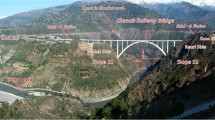Abstract
The main access road of Mae Mao dam hydropower project, Chiang Mai province, Thailand, has failed during a sunny day. The question has been raised of what might have triggered the failure. At the day of failure, the precipitation amount was very small and the accumulated rainfall amount in the past days was also not significant to trigger the failure. Detail geotechnical investigations were carried out including the geological survey, seismic refraction survey, bore holes drilling and various laboratory testing. The rock found at site was Phyllitic and Quartzitic sandstone. It appears that the engineering properties of Phyllitic sandstone are more susceptible for slope failure. Rock and soil slope stability analysis have been done, however none of them was found to be the cause of failure. After carefully reexamining the geologic structure, it was found that there is a weak plane layer that resulted in the failure. A suitable stabilization method has been selected as the economical remedy of the slope failure. In this case, flattening the back slope is the economic method along with the drainage system specially designed to reduce the pore water pressure of the weak plane layer. Rock bolts and rock anchors were found to be uneconomical and unsuitable. Probabilistic approach was used to optimize the engineering safety and construction cost.

























Adapted from Silva et al. (2008)

Similar content being viewed by others
References
ASTM (2002) ASTM D5607 standard test method for performing laboratory direct shear strength tests of rock specimens under constant normal force. ASTM Standards (Vol. 04.08). American Society for Testing and Materials, Philadelphia
Bieniawski ZT (1973) Engineering classification of jointed rock masses. Trans South Afr Instit Civ Eng 15:335–344
FHWA (2006) Soils and foundations. Referenece manual-vol.1. US Department of Transportaion, Federal Highway Administration, Washington
Hagiwara T, Omoto S (1939) Land creep at Mt. Tyausu-yama. Determination of slip plane by seismic prospecting. Bull Earthq Res Inst Bull 17:118–137
Hoek E, Bray JW (1981) Rock slope engineering, Revised 3 edn. The Institution of Mining and Metallurgy, London, pp 341–351
Mae Mao Hydropower Project (2006) Rainfall record data of mae mao hydropower project. Fang, Chiangmai
Mairaing M, Isaroranit R (2003) Slope stability analysis with KUslope Version 2.0., pp. 95–114. Foundation Engineering 2003 Past Present and Future. Sub-committee in Geotechnical Engineering, Engineering Institute of Thailand, Bangkok
Markland JT (1972) A useful technique for estimating the stability of rock slopes when the rigid wedge slide type of failure is expected. Imperial College Rock Mechanics Research Reprints, London
Phoon K-K, Kulhawy FH, Grigoriu MD (1995) Reliability-based design of foundations for transmission line structures. Report TR-105000, Electric Power Research Institute, Palo Alto, CA, 380 p
Romana M (1985) New adjustment rating for application of the bieniawski classification to slopes. In: Proceedings of the international symposium rock mechanics mining civil works. ISRM, Zacatecas, Mexico. pp 59–63
Santamarina JC, Altschaeffl AG, Chameau JL (1992) Reliability of slopes incorporating qualitative information. Transportation Research Board, Washington
Silva F, Lambe TW, Marr WA (2008) Probability and risk of slope failure. J Geotech Geoenviron Eng. https://doi.org/10.1061/(asce)1090-0241(2008)134:12(1691). The Meteorological Department. 2006. Earthquake Report. Available source
Thai Meteorological Department (2007). http://www.tmd.go.th/
Acknowledgements
The authors would like to thank Department of Alternative Energy Development and Efficiency and also the staff at Mae Mao hydropower project.
Author information
Authors and Affiliations
Corresponding author
Additional information
Publisher’s Note
Springer Nature remains neutral with regard to jurisdictional claims in published maps and institutional affiliations.
Rights and permissions
About this article
Cite this article
Soralump, S., Isaroran, R. & Yangsanphu, S. Weak Plane Failure of Phyllitic Sandstone: Back Analysis for Slope Stabilization and the Use of Probabilistic Approach for Design Optimization. Geotech Geol Eng 37, 2315–2324 (2019). https://doi.org/10.1007/s10706-018-0756-8
Received:
Accepted:
Published:
Issue Date:
DOI: https://doi.org/10.1007/s10706-018-0756-8




